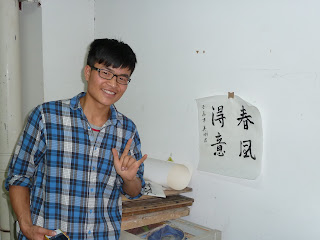Our final weeks in Xi’an included events that
allowed for more dialogue regarding the purpose of the partnerships being forged
between the University of Kentucky and the schools in Gaoxin’s High Tech
Industries Development Zone. Following a
dinner hosted by the university, several administrators and teachers asked if
Dr. Henry could give a presentation about American teaching and learning theories
and methodologies. Here, some of the
English teachers from Gaoxin No. 1 High School and Gaoxin No. 2 Primary School
take notes about student centered classrooms and collaborative learning.


Dr. Henry was invited to teach an “open class” at Gaoxin No. 2 Primary School where I had spent a few weeks collaborating with the English teachers. The concept of an open class is common in this school where the teachers are required to observe other teachers a certain number of times per term. The purpose is to exchange ideas and promote professional development. Approximately 8 teachers observed as Dr. Henry taught a class of 60 5th graders the present continuous tense. She used the text book from the class and then added activities that are typical in American classrooms such as cooperative learning and learning centers. The students were very enthusiastic and the teachers were quite interested in this method of learning.

Following the class, the teachers gathered in the
principal’s office for a feedback session.
The teachers expressed their appreciation for Dr. Henry’s modeling of
student centered learning. The assistant
principal and the teachers served tea and fruit before we had to say good
bye. Many comments were made regarding
the benefits of an exchange between Chinese and American interns and
teachers.
The Chinese cooperating teachers noted that they
had been impressed with the inclusiveness and creativity displayed by the
University of Kentucky student teacher interns during this first embedded
student teaching program in China.
Certainly the experience in the Chinese classrooms and observing their
cooperating teachers was beneficial for the U.K. students as well.
All in all, the first group from University of
Kentucky and our hosts at Gaoxin seem to agree that a deeper understanding of
the methods and motives of diverse educational systems is a worthwhile endeavor.









